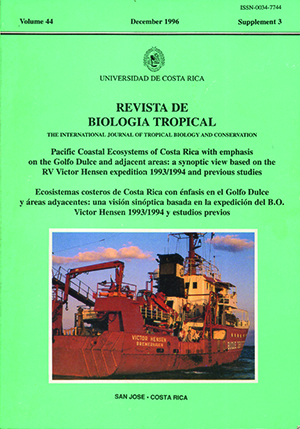Abstract
A list of 54 copepod species (Crustacea) in 23 families is presented for the Pacific coast of Costa Rica. Identifications are from zooplankton samples of the Victor Hensen Expedition during December 1993 and February 1994. Samples were taken with a Bongo net (0,60 m net opening. 2.50 m net length) with 200 μm mesh size. Oblique hauls were done from the surface to the ground at a towing speed of aprox. 1 knot. 37 species (68.5%) we re found in the Gulf of Nicoya. 36 in Golfo Dulce (66.6%) and 17 (31.4%) species were common to both gulfs. while only twelve species (22.2%) were found in Coronado Bay. Four species (7.4%) were distributed along the coast and were common to the three regions: Paracalanus parvus, Euchaeta sp., Oithona plumifera and O. similis. Eleven species of calanoids found normally in the Costa Rica Dome show the influence of typical oceanic waters principally at the mouth of Gulf of Nicoya. Differences were observed in the composition and presence of the copepod species when the inner and outer (upper and lower) pans of both gulfs were compared. Gulf of Nicoya was dominated in its upper pan by typical neritic estuarine species like Acartia lilljenborgii. Paracalanus parvus and Hemicyciclops thalassius as well as species of Pseudodiaplomus. On the other hand a more oceanic composition of copepods was observed in the lower part of the gulf. BOth small species, like Oncaea venusta, as well as larger species, such as Pleuromamma rubusta, Eucalanus attenustus, E. elongatus and Rhinalanus nasatus, were typical of these waters. Oithona plumifera and O. similis were found in the lower part too; and both species are typical from oceanic water. Coronado Bay was characterized by the presence of typical oceanic species like Neocalanus gracilis, Euchaeta longicornis, Eucalanus attenuatus and Haloptilus ornatus with more transitional species like Clausocalanus pergens and C. furcatus near the coast. In the Golfo Dulce differences in copepod composition were also observed, but the separation of the species was not so evident. Outer stations were represented by oceanic species like Paracalanus aculeatus, Pleuromamma gracilis, Lucicutia ovalis, Candancia catula, Euchaeta wolfendendeni and Oncaea mediterranea, while the inner station, located at the upper pan of the Gulf, was more characterized by a mixed copepod group. with both neritic species like Pseudodiaptomus wrighti, Acartia danae, A. clausi, Canthoralanus pauper as well as oceanic species like ScolicitricelIa marginata, Saphirina nicramaculata or Oncaea conifera. Two species of Coryceaus, C. flaccus and C. speciosus, were identifed in the outer stations of Golfo Dulce. while C. brehmi was found in inner stations of Gulf of Nicoya. The majority of copepods found are typical of the east Pacific. This paper constitutes an additional work about the copepods in the Gulf of Nicoya and the first report of copepod species for Coronado Bay and Golfo Dulce.Comments

This work is licensed under a Creative Commons Attribution 4.0 International License.
Copyright (c) 1996 Revista de Biología Tropical
Downloads
Download data is not yet available.


